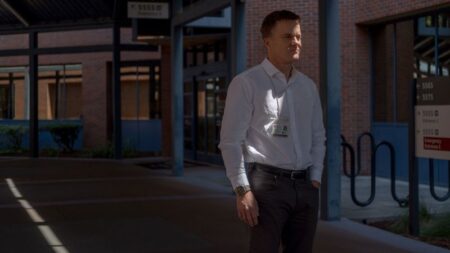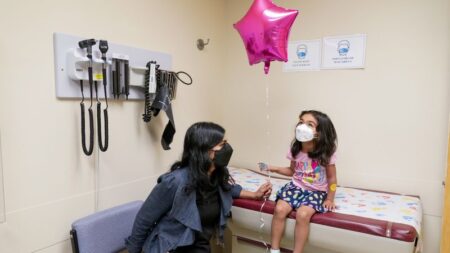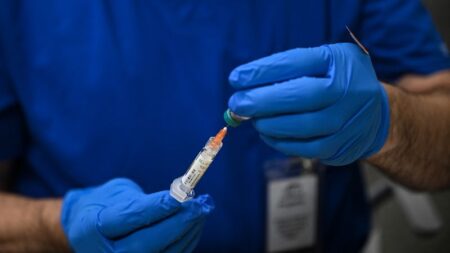Leah Rae Russell, a resilient individual from South Sioux City, Nebraska, embarked on an incredible transformation journey over the span of a decade, shedding over 200 pounds. However, she emphasized that her accomplishment remained incomplete until she took the final and necessary step of having surgery to tighten and remove about three pounds of excess skin from her chest and stomach. This act became essential for both her self-esteem and physical comfort, as she had been dealing with skin rashes caused by the hanging skin on her midsection.
The changes Russell experienced post-surgery were dramatic. She frequently found it difficult to recognize herself in the mirror, as she had adapted to her previous appearance over the years. “I find myself looking in mirrors a lot,” she explained. “It comes off very conceited, but really, it’s about accepting that what you’re seeing is your body.” Following two surgical procedures about two months before the interview, she had seen significant improvements, even though she was still in the healing phase.
The issues associated with excess skin led Russell to endure physical discomfort, as the skin hanging from her midsection was not only unsightly but also painful. She described the irritation, stating, “My belly button would be bleeding and raw all the time.” This condition drove her to recognize that excessive skin had become burdensome, further compelling her to seek surgical options.
Russell’s journey reflects a larger trend observed among individuals who have experienced significant weight loss, especially in light of the increase in the use of weight loss medications like Ozempic, which affects a whopping one in eight adults in the US. Dr. Steven Dayan, a board-certified plastic surgeon and clinical assistant professor at the University of Illinois, noted that surgeries to lift and tighten skin have surged in demand, particularly after the approval of the GLP-1 medication Wegovy in 2021. The rates of breast lifts, tummy tucks, and upper arm lifts have all increased significantly, indicating that many individuals are seeking to improve their body image and address the physical impacts of their weight loss.
Dr. Michele Shermak, another board-certified plastic surgeon, also pointed out that the demographic seeking such procedures has shifted, with younger individuals in their 30s and 40s more frequently desiring skin-tightening surgeries. These patients experience better recovery outcomes due to their relative youth compared to traditional patients who often undergo such procedures. Recovering from surgery and adapting to the changes in their bodies poses unique challenges and considerations for these patients.
Yet, despite the positive outlook for many, there are individuals like Russell who face complexities following weight loss. Some patients report dissatisfaction with the outcomes of skin tightening procedures, often stemming from altered skin elasticity that made it difficult to achieve desired results. Russell’s optimism was not without challenges, as the excess skin created clothing dilemmas and continued reminders of her past struggles with body image.
Russell herself faced her own hurdles during this transformative journey. She recounted the rollercoaster of her experiences, which began with her early struggles with disordered eating behaviors, leading her to try various weight control measures from a young age. Despite consistent efforts over the years, ranging from personal trainers to structured diet plans, her situation didn’t improve until she had a pivotal bariatric surgery in 2012, helping her start her significant weight loss journey.
However, after welcoming her daughter, Aurora, she regained some weight but remained determined, eventually resorting to GLP-1 medication combined with stimulants to aid in controlling binge-eating tendencies. After achieving a period of sustained weight management, she resolved to pursue skin removal surgery, despite knowing the challenges that lay ahead.
Financial and insurance hurdles complicated her efforts further, revealing the intricacies of securing coverage for such medical procedures. Russell’s desire to see herself without the remnants of obesity culminated in self-financed surgeries, resulting in positive physical and emotional outcomes that underscored her resilience. Through community support and her own research on skin removal experiences, she managed to tackle the complexities of this surgical journey with both caution and enthusiasm.
Despite the underlying risks associated with skin removal surgeries, including potential complications and the need for extensive recovery protocols, Russell emerged from her surgeries feeling invigorated. Eight weeks post-surgery, she found herself pleased with the results and noted minimal scarring. Ultimately, this transformative experience reaffirmed her sense of identity and self-acceptance, paving her way towards a healthy, confident future without the weight of her past. “I have no regrets,” she affirmed, showcasing her remarkable journey of resilience, improvement, and self-love.












